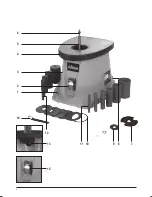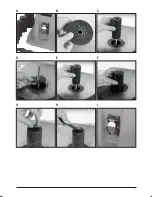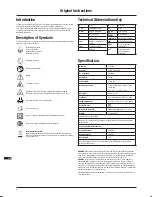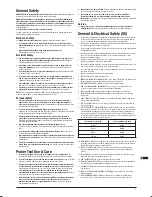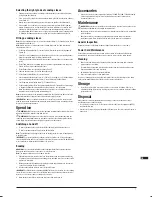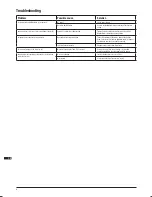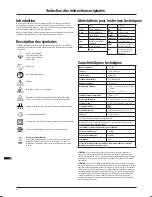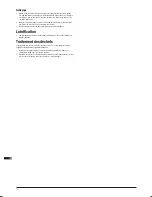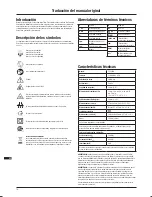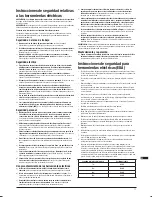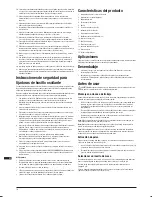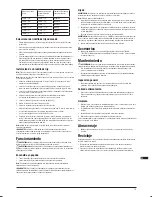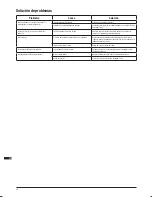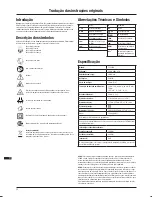
7
GB
Selecting the right grade of sanding sleeve
• Sanding sleeves are available in a variety of different grades: coarse (80 grit), medium
(150 grit) and fine (240 grit)
• Use a coarse grit to sand down rough finishes, medium grit to smooth the work, and fine
grit to finish off
• Always use good quality sanding sleeve to maximise the quality of the finished task
• It is advisable to do a trial run on a scrap piece of material to determine the optimum
grades of sanding sleeve for a particular job. If there are still marks on your work after
sanding, try either going back to a coarser grade and sanding the marks out before
recommencing with the original choice of grit, or try using a new piece of sanding sleeve
to eliminate the unwanted marks before going on to a finer grit and finishing the job
Fitting a sanding sleeve
Note:
All of the Sanding Sleeves (11), except the smallest 13mm (1/2”) Sanding Sleeve fit over
a matching Rubber Drum (12).
Note:
Ensure there is no contact between the Sanding Sleeve and the Table Insert before
turning the machine on.
1. Fit the Lower Spindle Washer (7) over the Spindle (5) with the grooves facing upwards
(Image D)
2. Select the correct Sanding Sleeve for the intended job. Select the corresponding Rubber
Drum, (except when using the 13mm sanding sleeve)
3. Select the appropriate Table Insert (10) in accordance with the table in ‘Selecting a table
insert’
4. Fit the Table Insert over the Spindle and onto the Lower Spindle Washer (see Image B).
Ensure the Table Insert is flush with the table
5. Fit the Rubber Drum over the Spindle (Images E and F)
6. Slide the Sanding Sleeve (7) over the Rubber Drum (6)
7. Fit the Upper Spindle Washer (9) over the Spindle
• Use the large washer with the 75mm (3”), 51mm (2”), and 38mm (1 1⁄2”) Rubber Drums
• Use the medium washer with the 26mm (1”) and 19mm (3⁄4”) Rubber Drums
• Use the small washer with the 13mm (1/2”) Sanding Sleeve
8. Fit the Spindle Lock Nut (6) on the Spindle (Images G and H). Tighten the nut just enough
to expand the Rubber Drum against the Sanding Sleeve. Do not over-tighten
• When the sanding sleeve is completely worn it is possible to turn it upside down and
maximise its service life by using the remaining grit
Note:
If the sleeve rotates on the drum when switched on, the Spindle Lock Nut has not been
sufficiently tightened to compress the drum and therefore grip the sleeve.
IMPORTANT: Do not
use a sanding sleeve that is too worn. This can lead to excessive heat
build-up and damage the rubber drum. Damaged rubber drums due to worn sanding sleeves
will not be covered under warranty.
Operation
WARNING:
ALWAYS wear eye protection, adequate respiratory and hearing protection, as
well as suitable gloves, when working with this tool.
WARNING:
ENSURE gloves and clothes worn do not have loose threads that could get
caught by the rotating spindle and drag your hand or head into the rotating spindle causing
severe injury. It is recommended to wear gloves that are not fabric based.
Switching on and off
• To turn the spindle sander on pull out the On/Off Switch (2) which hinges at the top
• To turn the spindle sander OFF, press in the On/Off Switch
Note:
The On/Off Switch is designed that it can be easily pressed in to turn off quickly when
in the ON position.
IMPORTANT:
To prevent operation by children remove the Switch Lock (15) by pulling away
from the On/Off Switch and store securely. Once the Switch Lock is removed the On/Off Switch
is non-functional so it is important the Switch Lock is not lost.
Sanding
WARNING:
Do not sand metal with this sander. Sanding metal will cause sparks that may
ignite wood and dust particles on the sander or in the workshop
Note:
The spindle rotates in an anti-clockwise direction
1. Check the machine is mounted securely on the workbench and the Spindle Lock Nut (6)
is fastened correctly with appropriate sanding sleeve and table insert, in accordance with
guidance in ‘Assembly’
2. Wear appropriate safety equipment, including face mask and safety glasses, then switch
on the dust extraction system (if available)
3. Turn the sander ON and allow the motor to reach full speed
IMPORTANT:
Feed the workpiece gradually, AGAINST the direction of rotation, onto the sanding
sleeve. Failure to do this could force the workpiece away from the sanding sleeve with risk of
injury. Do not force the workpiece or apply excessive force.
4. When finished, turn off the machine and disconnect from mains power
Accessories
• A range of accessories and consumables, including TSS80G, TSS150G, TSS240G Sanding
Sleeves are available from your Triton stockist. Spare parts can be obtained from
toolsparesonline.com
Maintenance
WARNING:
Ensure the tool is switched off and the plug is removed from the power point
before making any adjustments or carrying out maintenance.
• Any damage to this tool should be repaired and carefully inspected before use, by qualified
repair technician
• Have your power tool serviced by a qualified repair technician using only identical
replacement parts. This will ensure that the safety of the power tool is maintained
General Inspection
Regularly check that all the fixing screws are tight. They may vibrate loose over time.
Power Cord Maintenance
If the supply cord needs replacing, the task must be carried out by the manufacturer, the
manufacturer’s agent, or an authorised service centre in order to avoid a safety hazard.
Cleaning
1. Remove dust and dirt regularly. Frequently blow or vacuum dust away from all sander
parts and the motor housing
2. Periodically remove the table insert and lower washer from the spindle and remove any
dust accumulation in the table insert area
3. Re-lubricate all moving parts at regular intervals
4. Never use caustic agents to clean plastic parts
Do not use cleaning agents to clean the plastic parts of the tool. A mild detergent on a damp
cloth is recommended. Water must never come into contact with the tool.
Storage
• Store this tool carefully in a secure, dry place out of the reach of children. If the tool is
permanently setup in a workshop or garage ensure access is restricted to prevent children
operating the tool.
Disposal
Always adhere to national regulations when disposing of power tools that are no longer
functional and are not viable for repair.
• Do not dispose of power tools, or other waste electrical and electronic equipment (WEEE),
with household waste
• Contact your local waste disposal authority for information on the correct way to dispose of
power tools
700094_Manual.indd 7
12/10/2017 11:56
Summary of Contents for TSPS 450
Page 2: ...2 1 14 2 3 4 5 6 8 7 9 10 11 12 13 15...
Page 3: ...3 A D G B E H C F I...


